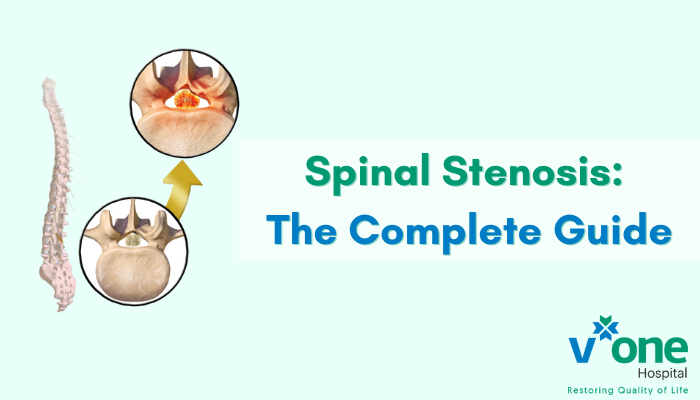Spinal Stenosis: Symptoms, Diagnosis, and Treatment Options
Our spine is the body’s main support system. It protects the spinal cord and helps us move, bend, and stay upright. But when something goes wrong, it can affect daily life in a big way. One such condition is spinal stenosis.
This blog will help you understand what spinal stenosis is, its symptoms, how it is diagnosed, and the treatment options available.
What is Spinal Stenosis?
Spinal stenosis is a condition where the spaces within your spine become narrow. This narrowing puts pressure on the spinal cord and the nerves that travel through the spine.
It can occur in any part of the spine but is most common in the lower back (lumbar spine) and the neck (cervical spine).
Some people may have spinal stenosis but do not notice symptoms right away. For others, the symptoms can gradually worsen over time.
Causes of Spinal Stenosis
The narrowing of the spinal canal can be caused by several factors, including:
- Aging: Wear and tear over the years can cause changes in the spine.
- Osteoarthritis: This can lead to bone spurs that reduce space in the spine.
- Herniated discs: Discs can press on nearby nerves.
- Thickened ligaments: Ligaments can stiffen and bulge into the spinal canal.
- Injuries: Accidents or falls can damage the spine.
- Tumors or abnormal growths: Rarely, these can narrow the spinal space.
Common Symptoms of Spinal Stenosis
The symptoms depend on where the narrowing happens.
1. Lumbar Spinal Stenosis (Lower Back)
- Pain or cramping in the legs when standing or walking
- Pain that improves when bending forward or sitting
- Numbness or tingling in the legs or feet
- Weakness in the legs
2. Cervical Spinal Stenosis (Neck)
- Neck pain
- Tingling or numbness in arms, hands, legs, or feet
- Weakness in arms or legs
- Difficulty with balance and walking
- In severe cases, loss of bladder or bowel control
Symptoms often develop slowly but can become more noticeable with time.
When to See a Doctor?
You should seek medical attention from an orthopaedic doctor in Indore if you experience:
- Severe or sudden weakness in the arms or legs
- Loss of bladder or bowel control
- Pain, numbness, or tingling that doesn’t go away
- Trouble walking or keeping balance
Prompt diagnosis can help prevent further nerve damage.
Diagnosis of Spinal Stenosis
A doctor will start by asking about your symptoms and medical history. A physical exam will follow, checking your balance, strength, and reflexes.
To confirm the diagnosis, the doctor may recommend:
- X-rays: Show bone changes like bone spurs.
- MRI scans: Give detailed images of soft tissues, nerves, and discs.
- CT scans: Useful if an MRI is not possible.
- Electromyography (EMG): Tests nerve and muscle function.
These tests help find the exact cause and location of the narrowing.
Treatment Options for Spinal Stenosis
Treatment depends on the severity of symptoms and how much they affect daily life.
1. Non-Surgical Treatments
Medications:
Pain relievers, anti-inflammatory drugs, and nerve pain medications can help.
Physical Therapy:
Exercises to strengthen muscles, improve flexibility, and support the spine.
Activity Modification:
Avoiding activities that worsen symptoms and adding more rest breaks.
Steroid Injections:
Reduce inflammation and relieve nerve pain.
These methods work well for mild to moderate symptoms.
2. Surgical Treatments
If symptoms are severe or not improving, surgery may be an option.
Common surgeries include:
- Laminectomy: Removes part of the bone to create more space.
- Laminotomy: Removes a small section of bone to relieve pressure.
- Foraminotomy: Enlarges openings where nerve roots exit the spine.
- Spinal Fusion: Joins two or more bones to stabilize the spine.
Surgery can greatly reduce symptoms but is usually considered only after other treatments fail.
3. Living with Spinal Stenosis
Managing spinal stenosis is not just about treatment—it’s also about lifestyle changes.
- Maintain a Healthy Weight: Reduces strain on the spine.
- Stay Active: Gentle exercises like walking, swimming, or yoga can help.
- Use Good Posture: Keeps the spine aligned and reduces pressure.
- Quit Smoking: Smoking can worsen spine problems.
Even after treatment, ongoing care is important to prevent symptoms from returning.
Outlook for People with Spinal Stenosis
With early diagnosis and proper management, most people can live an active life. While the condition cannot be completely reversed, treatments can control symptoms and improve quality of life.
The key is to take symptoms seriously, follow medical advice, and make healthy lifestyle choices.
Final Thoughts
Spinal stenosis may sound alarming, but understanding it is the first step toward managing it. Knowing the symptoms, getting the right diagnosis, and exploring treatment options can make a big difference.
If you or someone you know has symptoms of spinal stenosis, don’t ignore them. Visit an orthopaedic doctor to get the right care and protect your spine health for the future.

